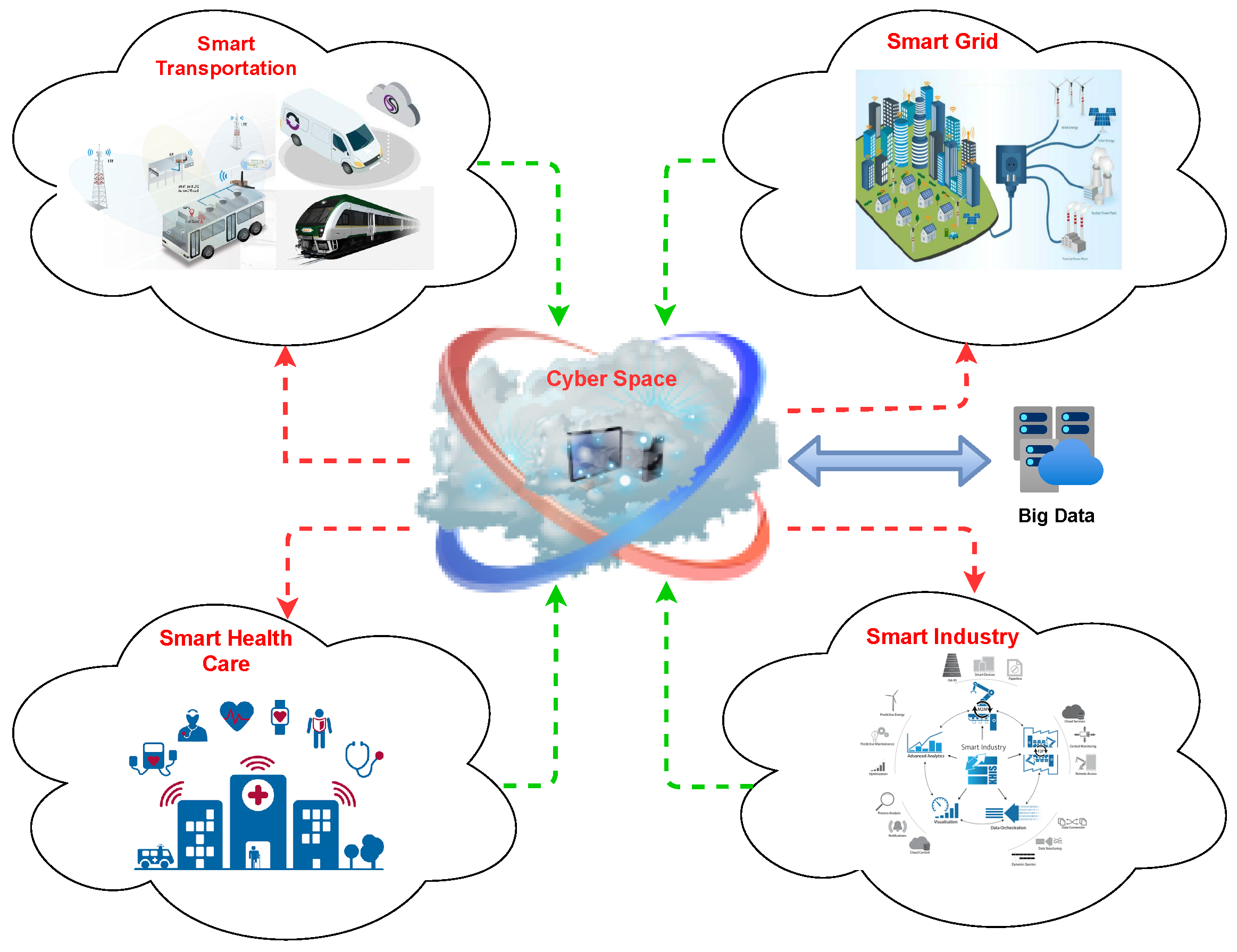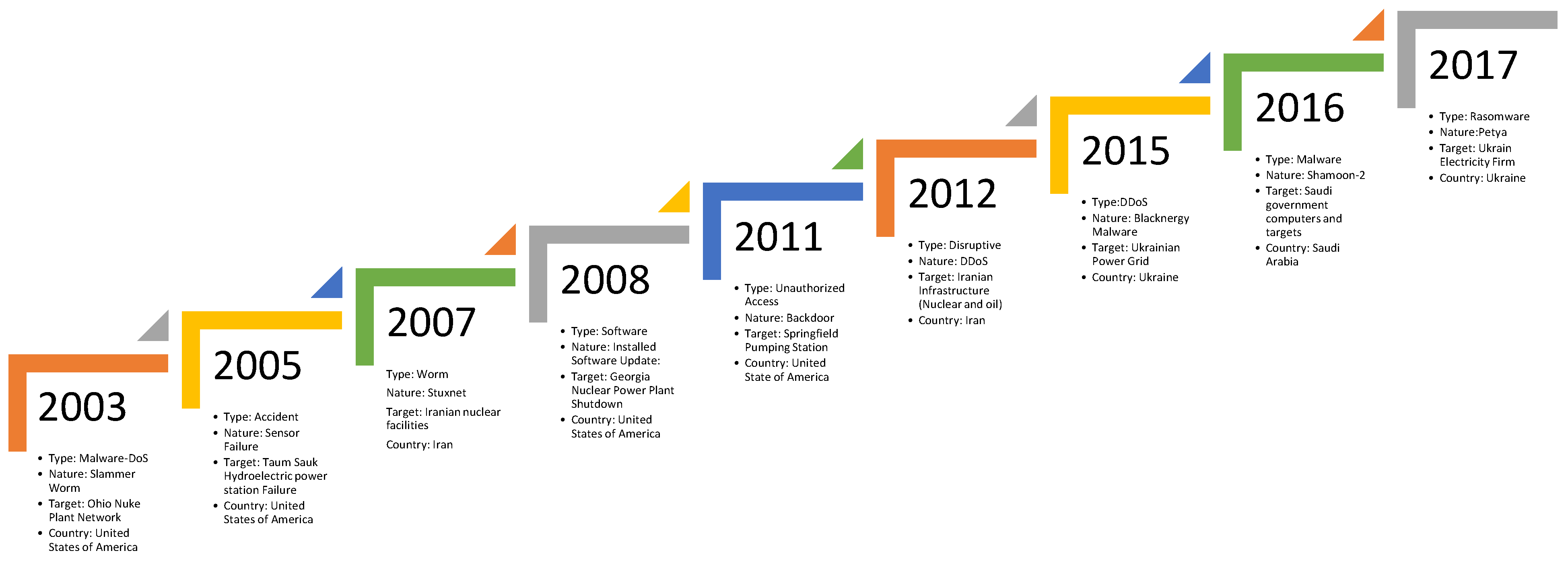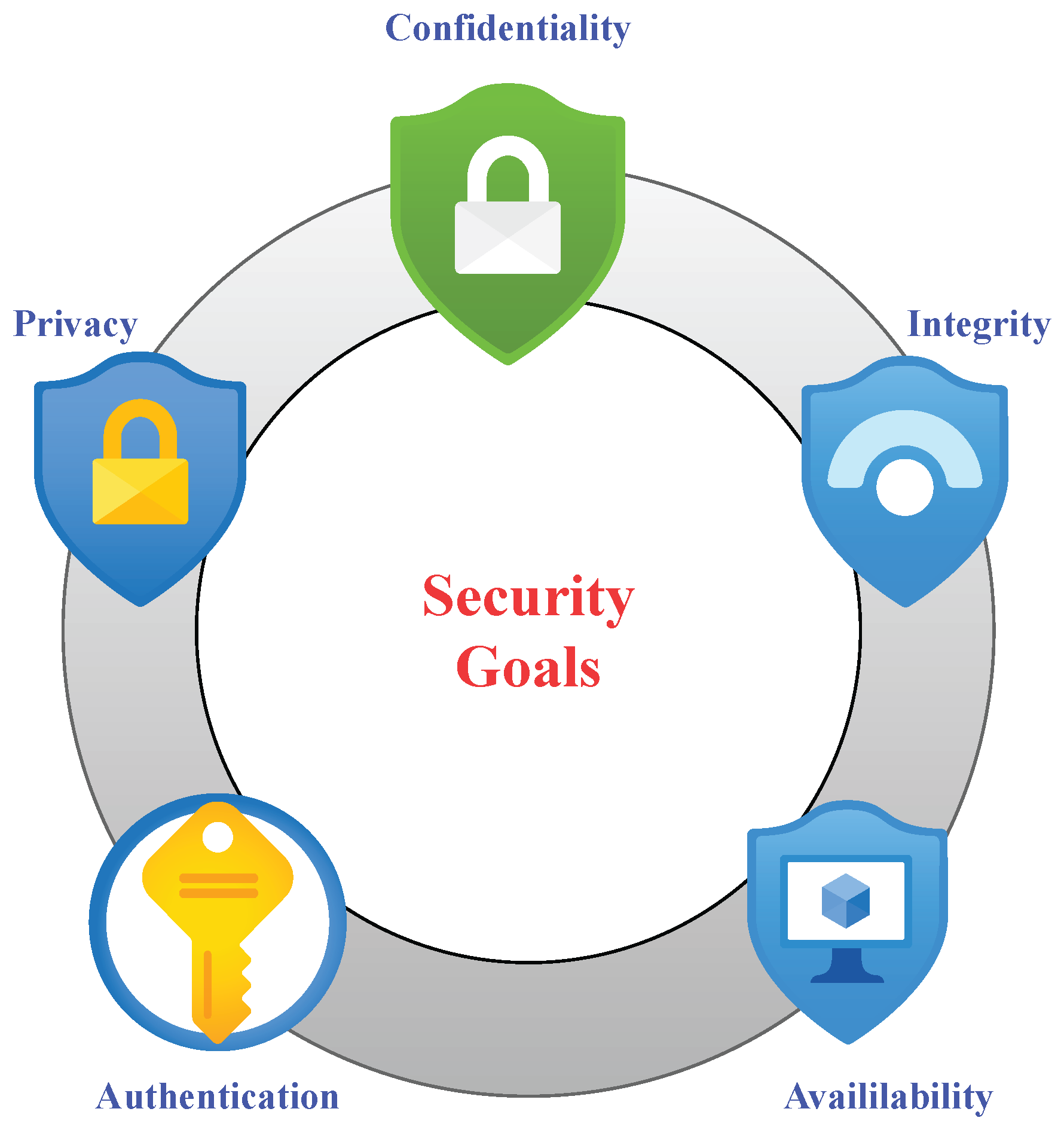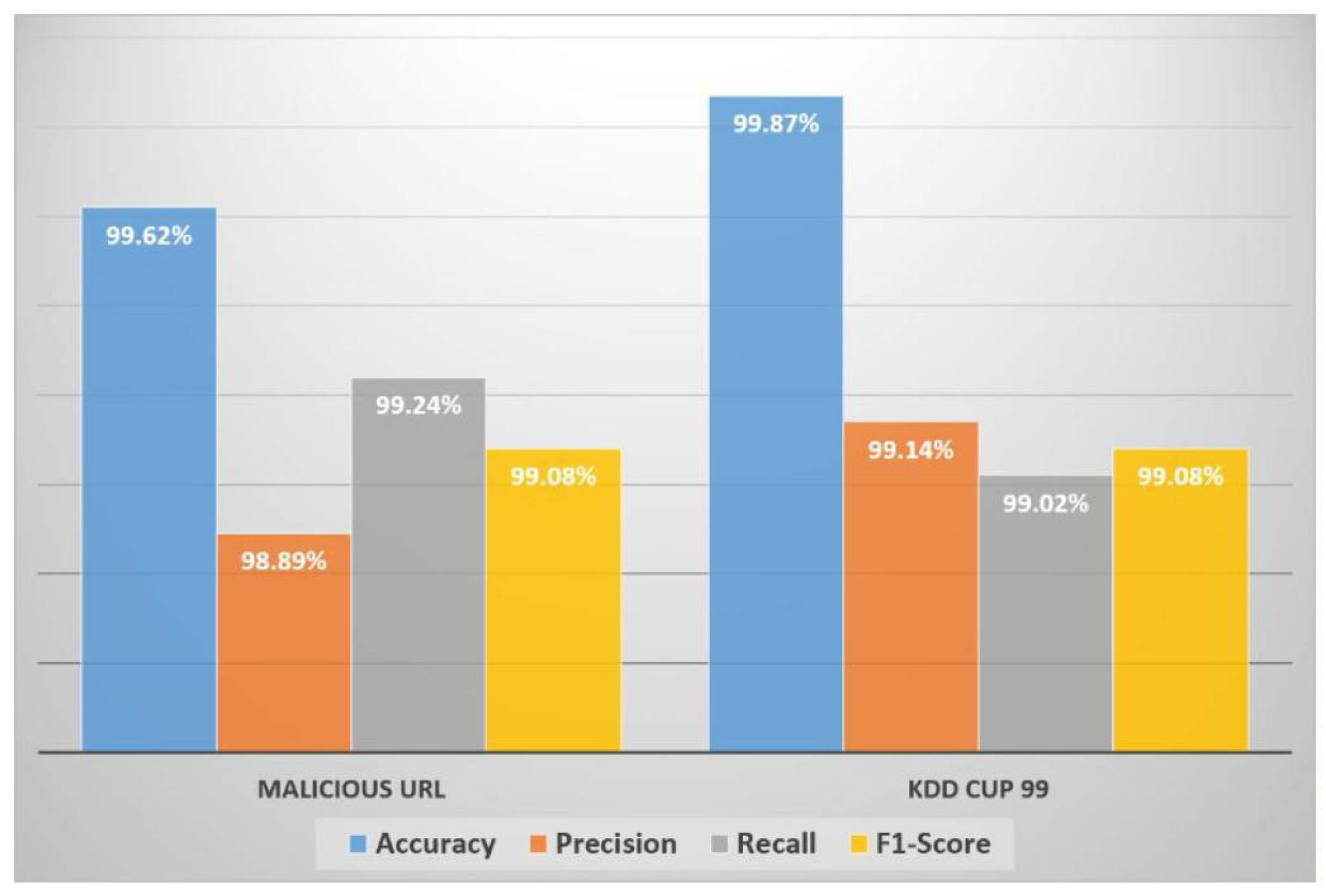Deep Learning-Based Intrusion Detection Methods in Cyber-Physical Systems: Challenges and Future Trends
Abstract
1. Introduction
- CPS architecture is presented into three layers, namely the physical layer, network layer, and application layer. The layered architecture is used to provide more clarity in terms of functionality. Then, CPS attacks on each layer are discussed, mainly from the perspective of the physical system.
- Key features, challenges, and attack handling methods using machine learning-based models are highlighted regarding different layers.
- Keeping in view the nature of different attacks, a simple deep learning model is deployed for attack detection, especially the detection of malicious URLs and CPS attacks. For this purpose, multilayer perceptron (MLP) is adopted as it is not used in the existing literature. Despite existing hybrid and sophisticated models, the proposed MLP provides better and more robust results.
- Finally, future research directions are outlined for CPS security research to handle CPS attacks in real-time networks.
2. Related Work
3. CPS Architecture, Layers and Components
3.1. Physical Layer
| Layer | Function | Attack | Target Area | Safety Measure |
|---|---|---|---|---|
 | Analysis of Data & Information | Code Injection Botnets Malware Trojans Worms Buffer Overflow | Security Privacy Authentication Safety | Firewall Strong Authentication Strong Authorization Trust Management |
 | Transmission of Data & Information | DoS/DDoS Repudiation Man in the middle Meet in the middle | Confidentiality Integrity Availability Authentication | Strong Password Policy Encryption Secure Tunneling |
 | Collection of Data & Information | Passive Replay Port Scan Eavesdropping | Privacy Authentication Confidentiality | Secure System Data Protection Source Authentication Trust Management |
3.2. Network Layer
3.3. Application Layer
4. Security Threats and Attacks
4.1. Attacks on Physical Layer
4.2. Attacks on Network Layer
4.3. Attacks on Application Layer
5. Securing CPS
5.1. Intrusion Detection Technique
5.2. Approach
6. Open Issues and Research Directions
- Delay in encryption and decryption process cause network latency;
- Weak scheme for user authentication and lack of multi-factor verification in devices;
- Lack of firewall protection;
- Insufficient Intrusion detection techniques;
- Need of cipher algorithms for CPS security;
- Strong user authentication;
- Data availability and verified backups.
- Many studies have been conducted for attack detection, but there is a need to consider real-time monitoring of CPS security. To employ real-time CPS security, the complexity of predictive models should be reduced to avoid data transmission delay.
- A resilient design of a CPS system for recovery after sensor attacks and software faults needs to be devised.
- Artificial intelligent-based models require sufficient data for training, so there is a need to generate a dataset for training and learning of malicious behaviors.
7. Conclusions
Author Contributions
Funding
Acknowledgments
Conflicts of Interest
Abbreviations
| Acronyms | Definition |
| ANN | Artificial neural network |
| BS | Base station |
| CRL | Certificate revocation list |
| CPS | Cyber-physical system |
| CPU | Central processing unit |
| DDoS | Distributed denial-of-service |
| DNP | Distributed network protocol |
| DoS | Denial of service |
| DRAM | Distributed random access memory |
| DT | Decision tree |
| GPS | Global positions system |
| IoT | Internet of things |
| MCA | Multiple correspondence analysis |
| MitM | Man-in-the-middle |
| MLP | Multilayer perceptron |
| PCA | Principal component analysis |
| PDA | Pole dynamic attack |
| PSO | Particle swarm optimization |
| R2L | Remote to user |
| RF | Random forest |
| RFID | Radio frequency identification |
| RIS | Reconfigurable intelligent surfaces |
| SMOTE | Synthetic minority oversampling technique |
| SVM | Support vector machine |
| U2R | User to root |
| URL | Uniform resource locator |
| ZDA | Zero dynamics attack |
References
- Lee, J.; Bagheri, B.; Kao, H.A. A cyber-physical systems architecture for industry 4.0-based manufacturing systems. Manuf. Lett. 2015, 3, 18–23. [Google Scholar] [CrossRef]
- Lee, J.; Lapira, E.; Yang, S.; Kao, A. Predictive manufacturing system-Trends of next-generation production systems. Ifac Proc. Vol. 2013, 46, 150–156. [Google Scholar] [CrossRef]
- Mozaffari, M.; Saad, W.; Bennis, M.; Nam, Y.H.; Debbah, M. A tutorial on UAVs for wireless networks: Applications, challenges, and open problems. IEEE Commun. Surv. Tutor. 2019, 21, 2334–2360. [Google Scholar] [CrossRef]
- Wehrmeister, M.A.; Freitas, E.P.; Pereira, C.E.; Wagner, F.R. An aspect-oriented approach for dealing with non-functional requirements in a model-driven development of distributed embedded real-time systems. In Proceedings of the 10th IEEE International Symposium on Object and Component-Oriented Real-Time Distributed Computing (ISORC’07), Santorini, Greece, 7–9 May 2007; IEEE: Piscataway, NJ, USA, 2007; pp. 428–432. [Google Scholar]
- Kim, S.; Won, Y.; Park, I.H.; Eun, Y.; Park, K.J. Cyber-physical vulnerability analysis of communication-based train control. IEEE Internet Things J. 2019, 6, 6353–6362. [Google Scholar] [CrossRef]
- Khalid, F.; Rehman, S.; Shafique, M. Overview of security for smart cyber-physical systems. In Security of Cyber-Physical Systems; Springer: Berlin/Heidelberg, Germany, 2020; pp. 5–24. [Google Scholar]
- Alladi, T.; Chamola, V.; Zeadally, S. Industrial control systems: Cyberattack trends and countermeasures. Comput. Commun. 2020, 155, 1–8. [Google Scholar] [CrossRef]
- Rawat, D.B.; Bajracharya, C. Detection of false data injection attacks in smart grid communication systems. IEEE Signal Process. Lett. 2015, 22, 1652–1656. [Google Scholar] [CrossRef]
- Shin, J.; Baek, Y.; Lee, J.; Lee, S. Cyber-physical attack detection and recovery based on RNN in automotive brake systems. Appl. Sci. 2018, 9, 82. [Google Scholar] [CrossRef]
- Olowononi, F.O.; Rawat, D.B.; Liu, C. Resilient machine learning for networked cyber physical systems: A survey for machine learning security to securing machine learning for cps. IEEE Commun. Surv. Tutor. 2020, 23, 524–552. [Google Scholar] [CrossRef]
- Tidjon, L.N.; Frappier, M.; Mammar, A. Intrusion detection systems: A cross-domain overview. IEEE Commun. Surv. Tutor. 2019, 21, 3639–3681. [Google Scholar] [CrossRef]
- Shojafar, M.; Taheri, R.; Pooranian, Z.; Javidan, R.; Miri, A.; Jararweh, Y. Automatic clustering of attacks in intrusion detection systems. In Proceedings of the 2019 IEEE/ACS 16th International Conference on Computer Systems and Applications (AICCSA), Abu Dhabi, United Arab Emirates, 3–7 November 2019; IEEE: Piscataway, NJ, USA, 2019; pp. 1–8. [Google Scholar]
- Mohammadi, S.; Namadchian, A. A new deep learning approach for anomaly base IDS using memetic classifier. Int. J. Comput. Commun. Control 2017, 12, 677–688. [Google Scholar] [CrossRef]
- Marteau, P.F. Sequence covering for efficient host-based intrusion detection. IEEE Trans. Inf. Forensics Secur. 2018, 14, 994–1006. [Google Scholar] [CrossRef]
- Hussain, J.; Lalmuanawma, S.; Chhakchhuak, L. A two-stage hybrid classification technique for network intrusion detection system. Int. J. Comput. Intell. Syst. 2016, 9, 863–875. [Google Scholar] [CrossRef]
- Aburomman, A.A.; Reaz, M.B.I. Ensemble of binary SVM classifiers based on PCA and LDA feature extraction for intrusion detection. In Proceedings of the 2016 IEEE Advanced Information Management, Communicates, Electronic and Automation Control Conference (IMCEC), Xi’an, China, 3–5 October 2016; IEEE: Piscataway, NJ, USA, 2016; pp. 636–640. [Google Scholar]
- Yan, M.; Chen, Y.; Hu, X.; Cheng, D.; Chen, Y.; Du, J. Intrusion detection based on improved density peak clustering for imbalanced data on sensor-cloud systems. J. Syst. Archit. 2021, 118, 102212. [Google Scholar] [CrossRef]
- Cho, E.M.; Perera, M.N.S. Efficient certificate management in blockchain based internet of vehicles. In Proceedings of the 2020 20th IEEE/ACM International Symposium on Cluster, Cloud and Internet Computing (CCGRID), Melbourne, VIC, Australia, 11–14 May 2020; IEEE: Piscataway, NJ, USA, 2020; pp. 794–797. [Google Scholar]
- Khan, S.; Zhu, L.; Yu, X.; Zhang, Z.; Rahim, M.A.; Khan, M.; Du, X.; Guizani, M. Accountable credential management system for vehicular communication. Veh. Commun. 2020, 25, 100279. [Google Scholar] [CrossRef]
- George, S.A.; Jaekel, A.; Saini, I. Secure identity management framework for vehicular ad-hoc network using blockchain. In Proceedings of the 2020 IEEE Symposium on Computers and Communications (ISCC), Rennes, France, 7–10 July 2020; IEEE: Piscataway, NJ, USA, 2020; pp. 1–6. [Google Scholar]
- Lu, Z.; Liu, W.; Wang, Q.; Qu, G.; Liu, Z. A privacy-preserving trust model based on blockchain for VANETs. IEEE Access 2018, 6, 45655–45664. [Google Scholar] [CrossRef]
- Akashdeep; Manzoor, I.; Kumar, N. A feature reduced intrusion detection system using ANN classifier. Expert Syst. Appl. 2017, 88, 249–257. [Google Scholar] [CrossRef]
- Musafer, H.; Abuzneid, A.; Faezipour, M.; Mahmood, A. An enhanced design of sparse autoencoder for latent features extraction based on trigonometric simplexes for network intrusion detection systems. Electronics 2020, 9, 259. [Google Scholar] [CrossRef]
- Gu, J.; Wang, L.; Wang, H.; Wang, S. A novel approach to intrusion detection using SVM ensemble with feature augmentation. Comput. Secur. 2019, 86, 53–62. [Google Scholar] [CrossRef]
- Yao, H.; Fu, D.; Zhang, P.; Li, M.; Liu, Y. MSML: A novel multilevel semi-supervised machine learning framework for intrusion detection system. IEEE Internet Things J. 2018, 6, 1949–1959. [Google Scholar] [CrossRef]
- Jia, Y.; Wang, M.; Wang, Y. Network intrusion detection algorithm based on deep neural network. IET Inf. Secur. 2019, 13, 48–53. [Google Scholar] [CrossRef]
- Mowla, N.I.; Tran, N.H.; Doh, I.; Chae, K. AFRL: Adaptive federated reinforcement learning for intelligent jamming defense in FANET. J. Commun. Netw. 2020, 22, 244–258. [Google Scholar] [CrossRef]
- Virupakshar, K.B.; Asundi, M.; Channal, K.; Shettar, P.; Patil, S.; Narayan, D. Distributed denial of service (DDoS) attacks detection system for OpenStack-based private cloud. Procedia Comput. Sci. 2020, 167, 2297–2307. [Google Scholar] [CrossRef]
- Alsirhani, A.; Sampalli, S.; Bodorik, P. DDoS detection system: Using a set of classification algorithms controlled by fuzzy logic system in apache spark. IEEE Trans. Netw. Serv. Manag. 2019, 16, 936–949. [Google Scholar] [CrossRef]
- Aburomman, A.A.; Reaz, M.B.I. A novel SVM-kNN-PSO ensemble method for intrusion detection system. Appl. Soft Comput. 2016, 38, 360–372. [Google Scholar] [CrossRef]
- Yaacoub, J.P.A.; Salman, O.; Noura, H.N.; Kaaniche, N.; Chehab, A.; Malli, M. Cyber-physical systems security: Limitations, issues and future trends. Microprocess. Microsyst. 2020, 77, 103201. [Google Scholar] [CrossRef]
- Andresini, G.; Appice, A.; Di Mauro, N.; Loglisci, C.; Malerba, D. Multi-channel deep feature learning for intrusion detection. IEEE Access 2020, 8, 53346–53359. [Google Scholar] [CrossRef]
- Jiang, K.; Wang, W.; Wang, A.; Wu, H. Network intrusion detection combined hybrid sampling with deep hierarchical network. IEEE Access 2020, 8, 32464–32476. [Google Scholar] [CrossRef]
- Lian, W.; Nie, G.; Jia, B.; Shi, D.; Fan, Q.; Liang, Y. An Intrusion Detection Method Based on Decision Tree-Recursive Feature Elimination in Ensemble Learning. Math. Probl. Eng. 2020, 2020, 2835023. [Google Scholar] [CrossRef]
- Gaddam, N.; Kumar, G.S.A.; Somani, A.K. Securing physical processes against cyber attacks in cyber-physical systems. In Proceedings of the National Workshop for Research on Transportation Cyber-Physical. Systems: Automotive, Aviation, and Rail, Washington, DC, USA, 18–20 November 2008; pp. 1–3. [Google Scholar]
- Lin, Z.; Niu, H.; An, K.; Wang, Y.; Zheng, G.; Chatzinotas, S.; Hu, Y. Refracting RIS aided hybrid satellite-terrestrial relay networks: Joint beamforming design and optimization. IEEE Trans. Aerosp. Electron. Syst. 2022, 58, 3717–3724. [Google Scholar] [CrossRef]
- Lin, Z.; An, K.; Niu, H.; Hu, Y.; Chatzinotas, S.; Zheng, G.; Wang, J. SLNR-based Secure Energy Efficient Beamforming in Multibeam Satellite Systems. IEEE Trans. Aerosp. Electron. Syst. 2022, 1–4. [Google Scholar] [CrossRef]
- Saqib, A.; Anwar, R.W.; Hussain, O.K.; Ahmad, M.; Ngadi, M.A.; Mohamad, M.M.; Malki, Z.; Noraini, C.; Jnr, B.A.; Nor, R.; et al. Cyber security for cyber physcial systems: A trust-based approach. J. Theor. Appl. Inf. Technol. 2015, 71, 144–152. [Google Scholar]
- Khan, S.; Luo, F.; Zhang, Z.; Rahim, M.A.; Ahmad, M.; Wu, K. Survey on Issues and Recent Advances in Vehicular Public-key Infrastructure (VPKI). IEEE Commun. Surv. Tutorials 2022, 24, 1574–1601. [Google Scholar] [CrossRef]
- Do Xuan, C.; Nguyen, H.D.; Nikolaevich, T.V. Malicious URL detection based on machine learning. Int. J. Adv. Comput. Sci. Appl. 2020, 11, 148–153. [Google Scholar]
- El-Sappagh, S.; Mohammed, A.S.; AlSheshtawy, T.A. Classification procedures for intrusion detection based on KDD CUP 99 data set. Int. J. Netw. Secur. Appl. (IJNSA) 2019, 11. [Google Scholar] [CrossRef]
- Tavallaee, M.; Bagheri, E.; Lu, W.; Ghorbani, A.A. A detailed analysis of the KDD CUP 99 data set. In Proceedings of the 2009 IEEE Symposium on Computational Intelligence for Security and Defense Applications, Ottawa, ON, Canada, 8–10 July 2009; IEEE: Piscataway, NJ, USA, 2009; pp. 1–6. [Google Scholar]
- Jia, B.; Ma, Y.; Huang, X.; Lin, Z.; Sun, Y. A novel real-time ddos attack detection mechanism based on MDRA algorithm in big data. Math. Probl. Eng. 2016, 2016, 1467051. [Google Scholar] [CrossRef]





| Ref. | Methods | Dataset | Findings |
|---|---|---|---|
| [13] | Memetic | NSL-KDD & KDD99 | PSO with higher accuracy |
| [14] | SC4ID algorithm | UNM & ADFA-LD | A new, more accurate approach for handling abnormal system calls. |
| [15] | SVM-ANN | NSL-KDD | High performance by a hybrid model |
| [16] | PCA-LDA-SVM | KDD-CUP 99 | Dimensionality reduction |
| [22] | Deep learning | KDD-CUP 99 & NSL-KDD | Deep learning model with reliable outcomes. |
| [23] | Sparse autoencoder | CICIDS 2017 | Uses trigonometric simplexes |
| [24] | SVM | NSL-KDD | The logarithmic marginal density ratio |
| [25] | MSML | KDD-CUP 99 | Multi-level intrusion detection |
| [27] | Q learning | CRAWDAD | Federated jamming |
| [28] | DT, KNN, NB & DNN | KDD-CUP 99, open-stack cloud | Socket programming and OpenStack firewall |
| [29] | Fuzzy logic | DDoS attack (T-shark) | Dynamic DDoS attack detection |
| [30] | SVM-KNN-PSO | KDD 99 | High precision ensemble model utilising a weighted method. |
| [31] | MDRA | KDD-CUP 99 | Real-time attack detection |
| [32] | MINDFUL | KDD-CUP 99, UNSW-NB 15, CICIDS 2017 | Multi-channel for deep feature learning |
| [33] | Deep hierarchical | NSL-KDD & UNSW-NB15 | Data balancing using SMOTE |
| [34] | DT-RFE | KDD-CUP 99 & NSL-KDD | Stacked approach |
| Method | Dataset | Accuracy | Precision | Recall | F1-Score |
|---|---|---|---|---|---|
| Proposed | Malicious URL Detection | 99.62 | 98.89 | 99.24 | 99.08 |
| SVM [40] | 90.70 | 93.43 | 88.45 | - | |
| RF [40] | 96.28 | 91.44 | 94.42 | - | |
| Proposed | KDD Cup 99 | 99.87 | 99.14 | 99.02 | 99.08 |
| Deep Learning [41] | 92.00 | - | - | - | |
| Rule Based Model [41] | 89.00 | - | - | - | |
| DT-RFE [34] | 99.21 | - | - | - |
| Sr# | Accuracy | Precision | Recall | F-Score |
|---|---|---|---|---|
| 1st-Fold | 99.5% | 98.6% | 99.1% | 99.1% |
| 2nd-Fold | 99.2% | 98.7% | 99.2% | 98.6% |
| 3rd-Fold | 99.1% | 98.3% | 99.3% | 98.4% |
| 4th-Fold | 99.8% | 98.7% | 99.9% | 99.5% |
| 5th-Fold | 100.0% | 99.1% | 99.8% | 99.3% |
| 6th-Fold | 99.6% | 98.6% | 99.7% | 99.2% |
| 7th-Fold | 99.4% | 98.7% | 99.6% | 99.1% |
| 8th-Fold | 100.0% | 99.4% | 99.5% | 99.7% |
| 9th-Fold | 99.2% | 98.4% | 99.4% | 99.8% |
| 10th-Fold | 99.7% | 98.5% | 99.7% | 99.9% |
| Average | 99.60% | 98.81% | 99.16% | 99.01% |
| Ref. | Model | Dataset | DoS | Prob | R2L | U2R | Avg. Accuracy |
|---|---|---|---|---|---|---|---|
| Proposed | MLP | KDD-CUP 99 | 1.00 | 0.99 | 0.99 | 0.99 | 0.99 |
| [43] | PCA+MCA | 0.99 | 0.98 | 0.97 | 0.81 | 0.94 | |
| [32] | DNN | - | - | - | - | 0.92 | |
| [34] | DT-RFE | 0.99 | 0.99 | 0.97 | 0.99 | 0.99 | |
| Proposed | MLP | NSL-KDD | 1.00 | 0.99 | 0.99 | 1.00 | 0.99 |
| [15] | SVM-ANN | 1.00 | 0.99 | 0.77 | 0.88 | 0.91 | |
| [33] | Deep hierarchical | 0.96 | 0.68 | 0.60 | 0.61 | 0.83 | |
| [34] | DT-RFE | 0.99 | 0.99 | 0.98 | 0.99 | 0.99 |
Publisher’s Note: MDPI stays neutral with regard to jurisdictional claims in published maps and institutional affiliations. |
© 2022 by the authors. Licensee MDPI, Basel, Switzerland. This article is an open access article distributed under the terms and conditions of the Creative Commons Attribution (CC BY) license (https://creativecommons.org/licenses/by/4.0/).
Share and Cite
Umer, M.; Sadiq, S.; Karamti, H.; Alhebshi, R.M.; Alnowaiser, K.; Eshmawi, A.A.; Song, H.; Ashraf, I. Deep Learning-Based Intrusion Detection Methods in Cyber-Physical Systems: Challenges and Future Trends. Electronics 2022, 11, 3326. https://doi.org/10.3390/electronics11203326
Umer M, Sadiq S, Karamti H, Alhebshi RM, Alnowaiser K, Eshmawi AA, Song H, Ashraf I. Deep Learning-Based Intrusion Detection Methods in Cyber-Physical Systems: Challenges and Future Trends. Electronics. 2022; 11(20):3326. https://doi.org/10.3390/electronics11203326
Chicago/Turabian StyleUmer, Muhammad, Saima Sadiq, Hanen Karamti, Reemah M. Alhebshi, Khaled Alnowaiser, Ala’ Abdulmajid Eshmawi, Houbing Song, and Imran Ashraf. 2022. "Deep Learning-Based Intrusion Detection Methods in Cyber-Physical Systems: Challenges and Future Trends" Electronics 11, no. 20: 3326. https://doi.org/10.3390/electronics11203326
APA StyleUmer, M., Sadiq, S., Karamti, H., Alhebshi, R. M., Alnowaiser, K., Eshmawi, A. A., Song, H., & Ashraf, I. (2022). Deep Learning-Based Intrusion Detection Methods in Cyber-Physical Systems: Challenges and Future Trends. Electronics, 11(20), 3326. https://doi.org/10.3390/electronics11203326











